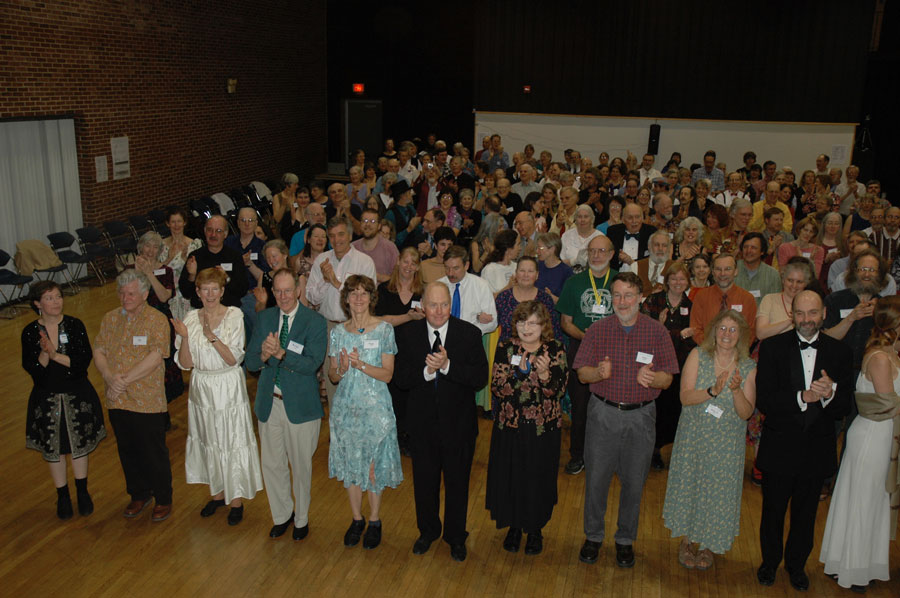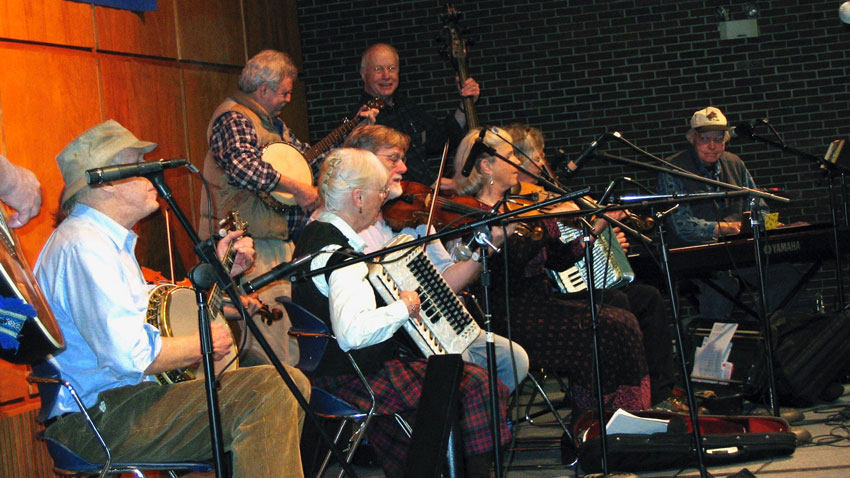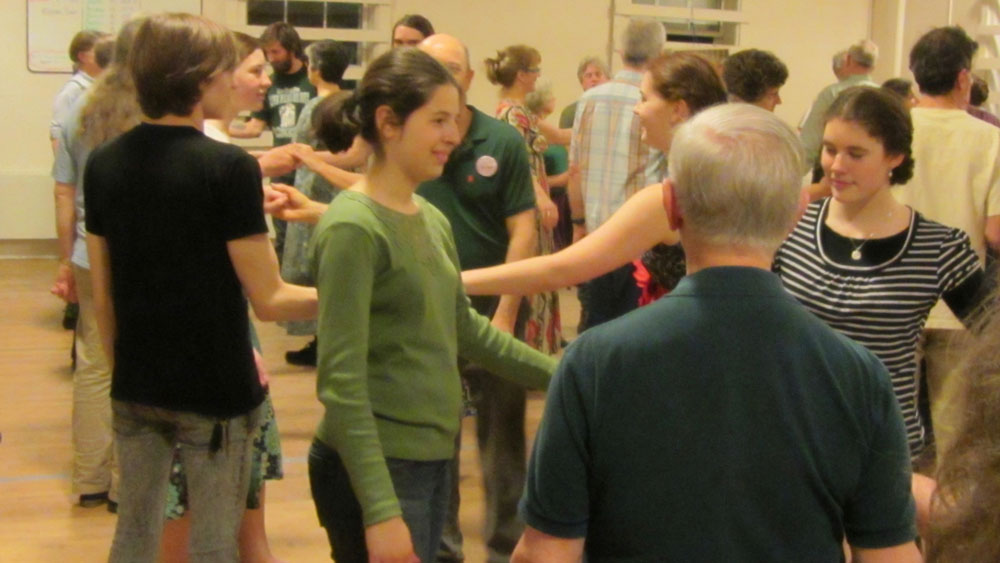On This Page
Here we look at generational changes: how have the dances changed as new generations of dancers, musicians and callers join the dance community? I have been dancing since a few years into the Contradance Revival led by Dudley Laufman, so I start with that one, and then move on to the presence of younger members of the dance community in recent years.
- The Contradance Revival: Generational & Cultural Influences. A variety of factors converged to affect dancing in the early 1970s and the next decade or so. This section looks at the generational and cultural changes that were happening.
- A Quick Look at How Things Changed. In this section I attempt to summarize some of the more major changes that happened at this time. Clearly many important people and changes were left out.
- The Return of Younger People to the Dance Community. For many hyears it seemed like the dance community was getting older. Sometime in the 1990s young people started dancing again. This section attempts to look at their impact.
- Recent Developments. Young people continue to join the dance community and I look at how they fit in and how things continue changing.
Contradance Revival & Change
The Contradance Revival: Generational & Cultural Influences
I started contradancing in the late 1970s. At that time the contradance revival was well underway. Most of the dancers (your editor included) were in their 20s and 30s I’d guess, and most got started with the revival. But there were some who started dancing before the revival came along. There was a pretty big distinction at that time between the more rural New Hampshire dancers and the urban dancers, mostly from Boston. The Boston dancers had danced to Ralph Page, and tended to be technically very good dancers, but many of them seemed to care more about being good dancers than about having a good time. Many of them wanted to make sure you knew they were good dancers, especially when compared with those rowdy New Hampshire dancers. Many of the long-time New Hampshire dancers had danced at Frank Fortune’s Barn in Bradford, NH which was a very large and at times rather boisterous dance.
I have to add that many Boston dancers were quite friendly. I remember watching Marianne Taylor, Ted Sannella, George Fogg and a few others at the Ralph Page Weekend and thinking about how long they’d been dancing together and how much fun they had together, and wondering if we would dance so well and have so much fun together when we were that age. But still, they were culturally quite different from most New Hampshire dancers.
Although I was only somewhat aware of it at the time, the different styles and backgrounds all came together at the Peterborough dance which was attended by both of those groups, as well as by the dancers who came along with the revival. (I missed what happened and heard about it second hand because I was at the Bowdoinham dance on first Saturdays.)
The latter group included a lot of back-to-the-land people and people who might have been labeled as hippies as well as the rural New Hampshire dancers. As I understand it, some of the Boston dancers liked to tell the New Hampshire dancers they were doing it wrong. They balanced wrong (onto the left foot first rather than the right foot), their style was wrong, etc. The New Hampshire dancers knew that the Monadnock region was one of the few places where dancing had continued uninterrupted for a couple hundred years, and they didn’t like being told they were wrong by people from Boston of all places.

The Ralph Page Dance Legacy Weekend attracted a large variety of dancers, especially in the earlier years.
Not only were there major cultural differences involved, but the revival grew fairly rapidly, and there was a sudden influx of a new generation of dancers who were quite different from the older dancers. They had long hair, dressed differently, some liked to dance barefoot, they viewed a dance as a place where one did not drink alcohol, and more.
Many of the Boston dancers thought we were too rowdy in our dance style, with loud balances, twirls on the ladies chains, and the energy of young dancers. At the same time some of the older New Hampshire dancers actually thought we were kind of boring because we didn’t drink at the break and thus didn’t act like many people do when combining drinking and dancing. I understand that the differences were enough to drive people away from the dances.
A Look at Changes
A Quick Look at How Things Changed
The contradance revival really got underway around 1970 plus or minus a couple years. The next substantial generation of new musicians, callers and dancers started to have an influence in the mid 1990s. I think the changes brought about by the contradance revival are best divided into at least a couple phases.
One of the biggest changes was a shift from emphasis on the caller to emphasis on the music. Although Dudley was immensely popular for a number of years he was probably at the root of this shift. The Canterbury Country Dance Orchestra was a loose collection of many of the best dance musicians in New England, and did a lot to bring in new dance musicians and turn them into excellent musicians. Here is a partial list of related people, bands and other forces for change.
- There was a revival of live music at dances; records were never part of the contradance revival. Furthermore, the music was often of very high quality.
- The Canterbury Country Dance Orchestra changed the sound of the music and inspired other country dance orchestras throughout New England as well as bringing in many excellent musicians.
- Newt Tolman was a link to an earlier period and its repertoire.
- Rod and Randy Miller’s New England Chestnuts recordings were a huge influence on many of us. They also played for dances in and around Durham with Tod Whittemore calling, which were favorites with local dancers.
- New England Tradition (Pete Colby, April Limber and Bob McQuillen) set the standard for traditional New England dance music for years, extending well after they ceased to exist.
- Bob McQuillen did likewise for New England piano as well as being a composer of many tunes and one of the most popular people in the contradance world. Old New England (Bob, Jane Orzechowski and Deanna Stiles) was also an important influence on New England dance music.
- More generally, callers were less controlling of dancing, dance style and what happened on the dance floor, and the dancers had attitudes influenced by the culture of the times.

The Canterbury Country Dance Orchestra playing at the Ralph Page Dance Legacy Weekend for a rare reunion in 2007.
There are many more that should be listed here. But let’s go on to the second phase. After a while people started changing things from the early contradance revival. Dances got more complex, and the music changed substantially. Here are a few of those changes.
- Rod Miller continued to develop his style, getting further from its original mixture of New England, French Canadian and Scottish (and probably other) influences. He started putting more influence from (as far as I can tell) rock & roll, jazz and blues into his fiddling.
- Swallowtail started playing very nice but complex arrangements of tunes with harmonies and switching instruments in and out, as well as using key changes in medleys to great effect.
- Wild Asparagus, the Clayfoot Strutters and others experimented with minimizing melody, rhythm and phrasing, sometimes all at the same time, making for music that was very popular with some dancers although I found it to be just plain undanceable at times. Some of what they came up with I thought would have been better as listening music because it was very well done and interesting, just didn’t have the qualities needed for dancing in my opinion.
- Dances got more complex. It got to the point where in order to be acceptable at a modern urban contradance a dance had to have a swing with the “number two” couple (as the inactives came to be called because they were just as active as the actives) and a partner swing. The pace of dances increased as well, with more being compressed into the same music.
Younger Musicians & Dancers Again
The Return of Younger People to the Dance Community
Expanded and updated from articles in the March 1998 and November 2003 issues of the Seacoast Country Dance Newsletter.
M oving ahead a number of years, there was a substantial period of time in which for the most part there were very few younger dancers. That started to change in the early 1990s, led as far as I can remember by people who had been home schooled both in New Hampshire and in Maine. By the late 1990s especially in Maine there were sometimes more younger dancers than dancers my age. I wrote articles about it in the Seacoast Country Dance Newsletter in 1998 and 2003. The first article especially forms the basis for the next portion of this article.
A few years ago it was starting to seem like all the dancers were getting older (which of course we are; although the last time I hinted that such things might happen I got several indignant responses, so apparently that's a taboo subject in our slightly weird culture)†. Over the past few years it's seemed like we may be getting a resurgence of interest among younger people. At Maine Fiddle Camp we've noticed that many of the participants are of high school age or younger; and many of them are quite good.
More recently there have been a number of younger people becoming interested in playing for dances in New Hampshire as well. And of course many of them enjoy dancing as well. We've also been getting more college students dancing recently. Again Maine is leading the way. The Bowdoinham dance, on those rare occasions I'm able to get there, probably has more young people attending than people my age, thus restoring the energy and enthusiasm that it always had when I first started dancing there nearly twenty years ago. I've noticed more college students coming to Seacoast dances in the past several months too. If this trend continues I'd say it's a very good sign for the future health of traditional dancing in New England.
Of course we have to keep in mind that when many of us first started dancing we changed the nature of the dancing enough that many older dancers stopped enjoying the dances and even stopped coming. It's very likely that if younger people start coming to the dances in larger numbers they will also change the character of the dances in some important ways, and many of us may not like the results.
In this photo you can see that there were dancers of a variety of ages at a Concord, NH dance in 2012.
It's even likely that some dances will be oriented more toward the preferences of younger dancers, while others will be more oriented toward older dancers. In fact, we may look back and decide that such a thing has already started to happen. Although I've never read much about it, I wonder if similar shifts have occurred in the past. Certainly it's always been the role of the older generation to point out that the young people really don't do it right or as well as they used to!
† Sometime in 1996 or 1997 I went to the Nelson dance for the first time in several years. The most striking thing was for obvious reasons that people (including me) looked older than they did several years previously. I commented on that fact, pointing out the obvious, that how could it be otherwise. Over the next few weeks I received more mail and email than I had on any other article I’d ever published, nearly all of it indignant, insulted and even angry at me for pointing out what I thought was an obvious and unavoidable fact. I learned that the fact that we age as we get older is apparently a taboo subject. How weird!
Recent Developments
Recent Developments
In the intervening years there has continued to be an influx of younger dancers although to a lesser extent. The younger dancers referred to above are in their 30s to near 50. The music and dance was still being changed by people my age and older who came in with the contradance revival. It has continued to change since.
The older musicians and callers still contribute to the changes by writing and calling dances most suitable for younger dancers, and by pushing the music further away from where it was twenty years ago. And it must be said that some older dancers like the modern style quite well. But the younger musicians and callers have moved in somewhat different directions. I am less familiar with their style so I won’t attempt to comment in more detail.
So the resulting changes involve a multi-generational interaction. Counting the people in their 30s and 40s as still young people, I’d say that group and the younger participants have taken over as the driving force behind changes, and they are starting to take over more of the leadership of the dance community.
That is as it should be in a living tradition. I think it’s still important to try to preserve the core aspects of the tradition, which can only be done by trying to communicate to the new people coming along why we think they are important and enjoyable. Clearly there’s been some success.
For example, every year at the Ralph Page Dance Legacy Weekend during lunchtime a set of dancers starts to form, and people playing for the jam session are informed it’s time to play Money Musk. The dancers start dancing and keep dancing as long as we’ll play for them. That has been organized every year by some of the younger musicians and dancers at the weekend.
But it’s important to recognize that people of different ages and backgrounds will enjoy different styles. So it’s probably a good thing that in fact some dances are more oriented toward younger dancers and some more toward older dancers, sometimes changing from month to month depending on who is playing and calling.
